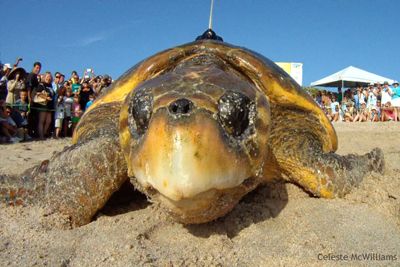In mid-July in Tortuguero, locals, tourists and media joined STC to watch the release of two green turtles freshly outfitted with satellite transmitters. Not even a tropical storm on the second day could stop over 200 well-wishers from excitedly cheering on the new contestants in this year’s Tour de Turtles on-line migration event (www.tourdeturtles.org).
There was a rare opportunity for people to see these beautiful creatures, aptly named Mora and Cruz, in the daylight and everyone here in Tortuguero has their fingers crossed that either one will be crowned the winner of this year’s Tour de Turtles ‘race!’
Sea Turtle Conservancy (STC) has received three grants awarded by Florida’s Sea Turtle Grants Program to support sea turtle-friendly lighting education and loggerhead migratory research.
Two of the grants focus on educating coastal residents in Florida about the impacts of beachfront lights to nesting females and sea turtle hatchlings and offering options for converting existing lights to amber LED fixtures that minimize impacts to sea turtles.
“It is important for people to see turtle-friendly lighting first-hand,” STC’s lighting specialist Karen Shudes said. “There are several myths about sea turtle-friendly lighting not being safe enough or bright enough, but these are simply not true.”
Artificial lights are a major threat to nesting sea turtles and hatchlings because 78% of Florida’s housing is located in coastal communities. These grants will help STC educate the public on the importance of making sure beachfront homes have the right type of lights to ensure safety for people and sea turtles.
The third grant is studying the migratory routes and foraging grounds used by loggerhead turtles from the Archie Carr Refuge in Melbourne Beach. The goal is to reveal important information about the turtles’ migratory behavior, foraging grounds, and the areas of potential conflict with commercial fisheries or legal harvest of sea turtles.

Currently, there are four turtles being tracked in this research study. Two turtles went to areas that STC had not observed before in the waters off Florida’s Panhandle and to the Yucatan Peninsula.
These grants are supporting critical programs that are increasing knowledge about sea turtles and providing solutions to ensure their survival. The grants were made possible by the sale of the “Helping Sea Turtles Survive” specialty license plate, which funds Florida’s Marine Turtle Protection Program and the Sea Turtle Grants Program. To learn more, visit www.helpingseaturtles.org.
Satellite-tracked turtle returns to nest again
by Ludi Lellis, Orlando Sentinel on May, 23 2011
About three years ago, she crawled off a Brevard County beach, a satellite tag glued to her back so that turtle fans could track her. Now, the loggerhead sea turtle has returned to Central Florida, back again at our beaches to nest again.
The return of the Belle O’Brevard, as she was named, has thrilled turtle researchers, who have learned much through satellite tagging of the sea-faring reptiles.
“Usually the transmitters don’t last long enough but on this turtle, we’ve been able to track her for three years,” said Rocio Johnson, with the Sea Turtle Conservancy in Gainesville.
The Belle O’Brevard was so named as part of a contest during the 2008 Tour de Turtles, an annual event hosted by the Sea Turtle Conservancy in which several turtles are fitted with satellite tags and then tracked for a marathon distance of 2,620 kilometers.
In 2008, this particular turtle, then weighing 350 pounds, had come ashore at the Archie Carr Refuge near Melbourne Beach to dig a nest but before she could return to sea, a fist-sized satellite transmitter was glued to her shell.
The transmitter has stuck, sending a satellite signal every three days. Her favorite migration path is between the Carolinas and Maryland, where she is apparently following the horseshoe migration season. You can see her migration map at this website.

She headed south to Florida a few weeks back and has been staying close to the Brevard coast. Turtles normally return to the beach where they first hatched to lay their own eggs and loggerheads are known to lay eggs about every two to three years. So it would seem that her biological clock is due for another round of nests.
Johnson noted, though, that no one has confirmed a nest, because no one has yet caught up with her at a beach during the nocturnal egg-laying.
______________________________________________________________
On behalf of STC, thanks for continuing to cover sea turtles, Ludi!